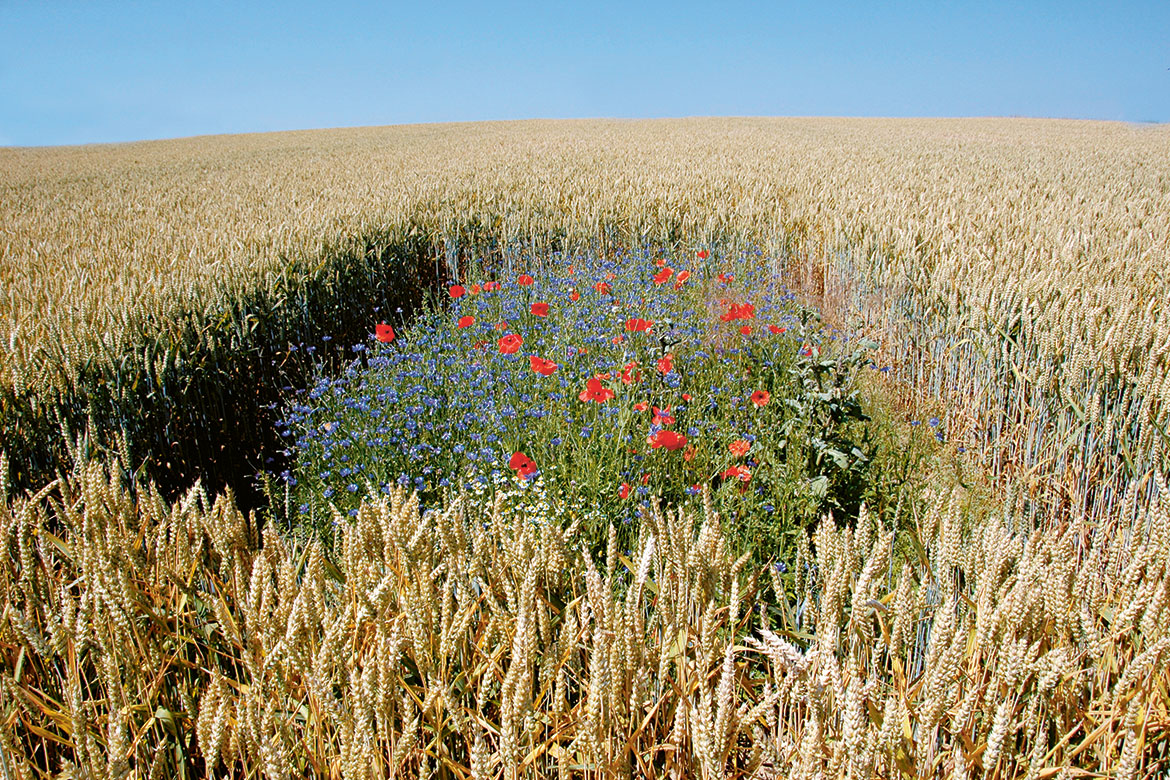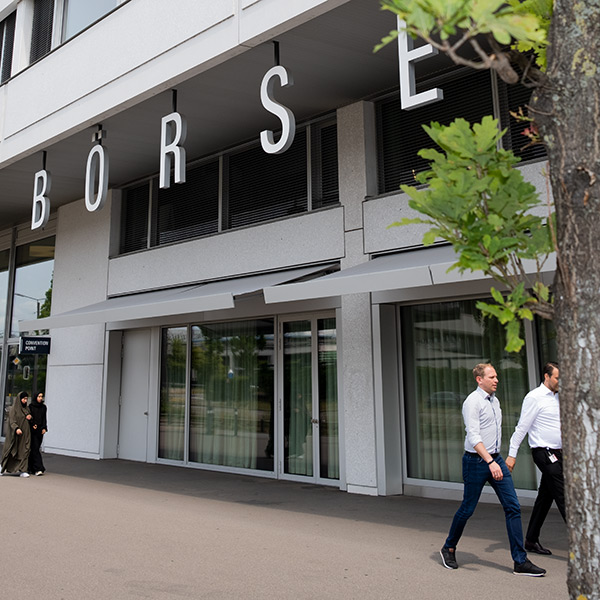Towards insect-friendly agriculture
It’s still not clear just how much Switzerland is affected by the insect die-off. But there are certainly fewer species on cultivated land. And farmers can do something about it.

Leaving strips or islands for wild flowers and plants in the midst of intensively cultivated land can be a simple means of supporting biodiversity. | Image: Markus Jenny
Researchers from all over the world are saying the same thing: something is rotten in the state of insects. But what about Switzerland? While we count our wolves and make precise inventories of our birds, there are actually few reliable statistics about our insects. The Red Lists only contain 2,500 species. Of these, 40 percent are endangered, including many butterflies and beetles. But no one knows exactly how things stand with the other insect species established in Switzerland, the number of which is estimated at some 28,000. Even ‘Biodiversity Monitoring Switzerland’, a project begun in 2001, isn’t expected to provide much data. Given the lack of experts and the immense expense involved, the project decided at the outset to concentrate on butterflies and aquatic insects.
In view of this grievous lack of data, is it even possible to make any definitive statement about the state of the insect world in Switzerland? Wolfgang Nentwig, a retired professor of ecology at the University of Bern, is unequivocal: “Everyone can observe the decline in insects. You see fewer insects at the streetlamps on an evening, and you see fewer large butterflies, ladybirds and grasshoppers. I think it’s completely superfluous to engage in more monitoring just for the sake of it, as it will take 20 years to give us the answers we need today”.
But the entomologist Ladislaus Reser from the Natur-Museum in Lucerne thinks we should take a more differentiated view of things. For the past 50 years he has been observing moths in Switzerland. “According to my own observations, recent years haven’t seen any sudden, large-scale extinction among Swiss moths”. At a suitable spot out in nature, when the weather is decent, he can count more than 200 different moth species in a single night. The emphasis here, however, is on “a suitable spot”. Because the more undisturbed a habitat, the more species and individual creatures can live there. “This is why we can’t simply dismiss negative findings. Moths – and probably other insects too – are disappearing from compromised areas, but this has been happening gradually for over 100 years at least”, says Reser.
The biologist Georg Artmann-Graf has observed the same trend. He has been making an inventory of insects in the Jura for more than 30 years now. “I have made a comprehensive catalogue of over 5,000 species, and both the number of species and the volume of actual insects have hardly altered throughout all these years. But the impoverishment of nature that I have experienced in the Swiss Midlands over the past 65 years is something I nevertheless regard as dramatic”.
Bigger habitats, less pesticides
The biggest problem for insects is thus their loss of habitat through urbanisation, the clearing of forests and, above all, through agriculture. Even on flowery grasslands that are somewhat extensively cultivated, less species live than one might like to think. One reason for this is the early mowing season. If this is shifted by four weeks to the middle of July, or if rows of plants are left untouched until the next mowing season, then the number of species and the biomass of pollinating and plant-eating insects increases considerably, as Raphael Arlettaz and his colleagues at the Institute of Ecology and Evolution at the University of Bern have observed.
Another problem for insects is the use of pesticides. Although usage sank between 1990 and 2004, it has since risen again and is now where it was twenty years ago – circa 2,200 tonnes a year. “We have to limit the volume of pesticides in use”, says Nentwig. “This is clearly a decision that our politicians have to make”. But the Federal Council rejected last year’s popular initiative in favour of a ‘Switzerland free of synthetic pesticides’. Nentwig thinks that the best option for achieving lower levels of pesticide use is to introduce genetically modified, insect-resistant plants. “But regrettably, genetic engineering isn’t welcome here, nor is it in Germany or Austria”. One alternative would be classical cultivation with support from genetic engineering, although first a suitable, naturally resistant gene would need to be found.
A package of measures for farmers
So how can farmers promote the survival of animals and plants on agricultural land? Since the 1990s, they have been compelled to farm up to seven percent of their land extensively. But this is insufficient to stop the loss of biodiversity, says Sibylle Stöckli of the Research Institute of Organic Agriculture (FiBL). “It’s not just a matter of quantity – we’ve achieved that. It’s about quality, about the right location, and about how the land is allocated and cared for”.
To this end, FiBL has been collaborating with the Swiss Ornithological Institute in Sempach on a project entitled ‘Scoring with biodiversity – farmers enrich nature’ that has produced a catalogue of 30 measures to promote biodiversity. The farmers participating in the project were asked to implement those measures that best suited their own circumstances. The researchers offered support by means of on-the-spot advice. They also developed an innovative scoring system to help farmers determine the degree of biodiversity on their land and the impact of measures taken, without their having to draw up a complete inventory of their plants and animal species. According to Stöckli, this has had a positive effect: “The farms we advised implemented more measures than those who didn’t take our advice, and they also scored a lot more points”. In future, the researchers want to make sure that more farmers, politicians and the general public are all better informed about plans for nature-friendly agriculture.
A twenty-year-long experiment at Hope Farm near Cambridge in England has proven that environmentally friendly agriculture can be successful. This farm practises conventional agriculture, but at the same time, it has planted hedges and strips of grass and flowers to provide birds with more opportunities for nesting and feeding. Over the years, despite intensive farming, the number of bird species and breeding pairs there has increased. If we take this fact as an indication of increasing biodiversity, then we can assume that insects, too, are enjoying greater diversity on the fields of Hope.




